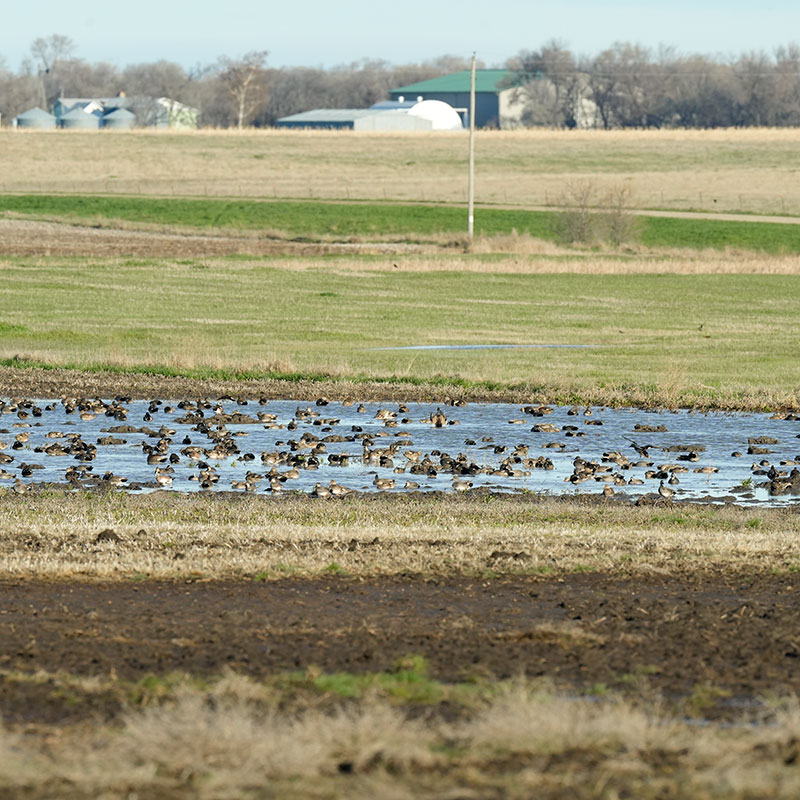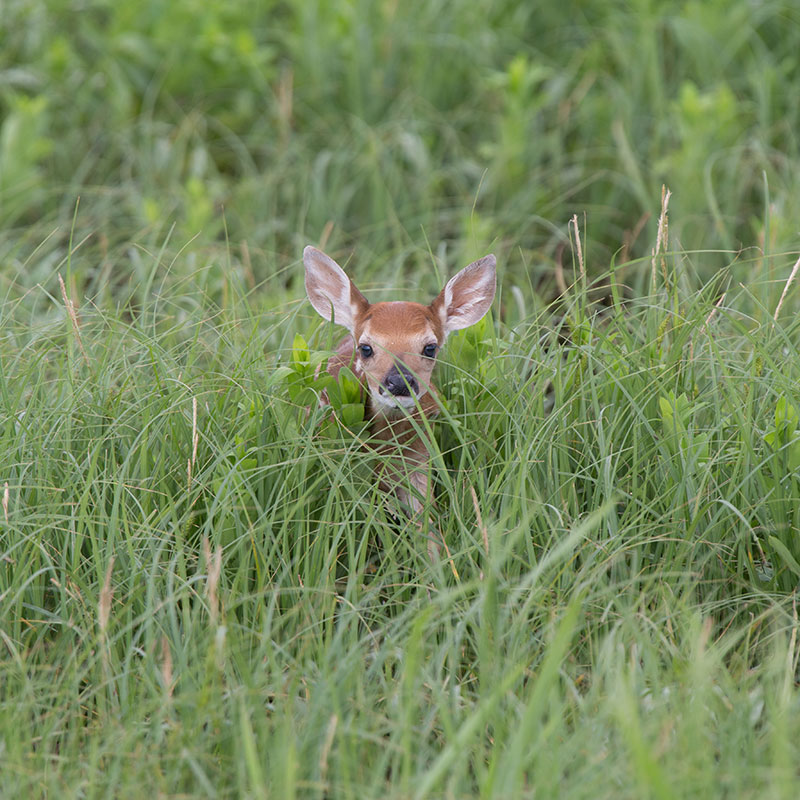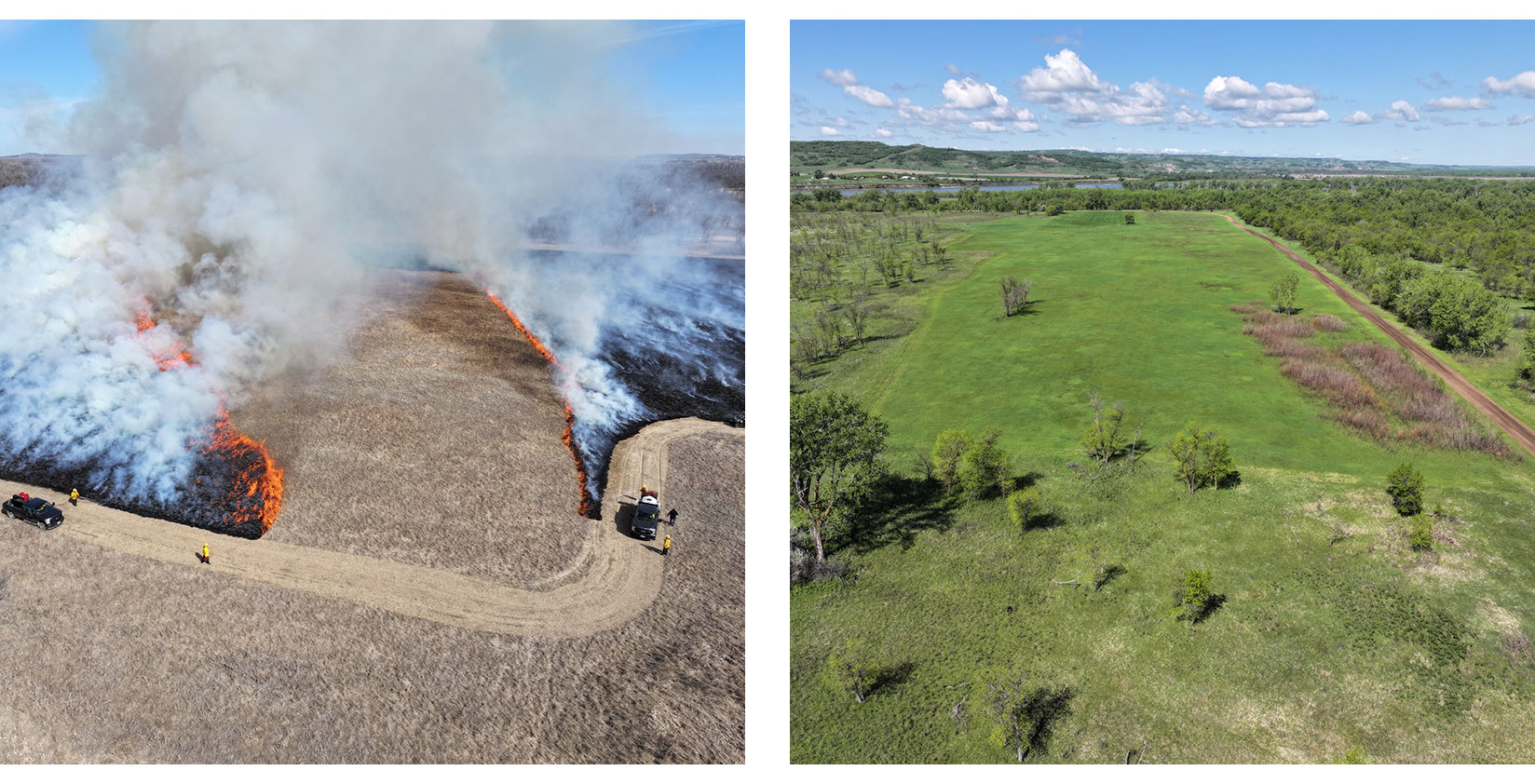
Buffaloberry Patch
Mule Deer Survey Completed

Results of the North Dakota Game and Fish Department’s annual spring mule deer survey indicate western North Dakota’s mule deer population is 1% higher than last year but 4% below the long-term average.
Biologists counted 2,047 mule deer in 286.3 square miles. The overall mule deer density in the badlands was 7.1 deer per square mile.
Bruce Stillings, Department big game management supervisor, said mule deer densities remained the same compared to 2023 following last year’s record low fawn production, reduced gun harvest and a mild winter in 2023-24.
“The 2024 spring survey results were largely influenced by the 2022-23 record-setting harsh winter, which resulted in mule deer does being in poor body condition last spring and record low fawn production in 2023,” Stillings said. “This past mild winter with higher survival helped offset lack of fawns from the previous two years, which led to mule deer populations being similar to last year.”
Biologists are encouraged that last winter’s mild conditions could result in higher fawn production this summer, leading to an increased population in 2025.
Biologists counted 1,735 mule deer in the aerial survey in October to determine demographics in the badlands. The ratio of 57 fawns per 100 does was the lowest recorded since the survey began in 1964, and similar to fawn production in 2011 and 2012 (59/100) following the extreme winters of 2008-10. The 39 bucks per 100 does was similar to 2022 (40/100) and the long-term average (43/100).
The spring mule deer survey assess mule deer abundance in the badlands. It is conducted after snow melt and before trees begin to leaf out, providing the best conditions for aerial observation of deer. Biologists have completed aerial surveys of the same 24 study areas since the 1950s.
The fall aerial survey, conducted specifically to study demographics, covers 24 study areas and 306.3 square miles in western North Dakota. Biologists also survey the same study areas in spring of each year to determine deer abundance.
2023 Upland Game Seasons Summary

North Dakota’s 2023 pheasant, sharp-tailed grouse and gray partridge harvests were up from 2022, according to the state Game and Fish Department.
RJ Gross, Department upland game biologist, said the overall harvest was likely a result of more hunters, more trips and more birds in the population.
“Despite enduring one of the highest snowfall totals in history (winter 2022-23), we anticipated an increase in upland bird harvests based on increases in all our metrics (number of birds, broods, brood size and age ratio) during our late summer roadside counts,” he said.
Last year, 53,819 pheasant hunters (up 5%) harvested 319,287 roosters (up 11%), compared to 51,270 hunters and 286,970 roosters in 2022. Counties with the highest percentage of pheasants taken were Hettinger, Divide, Burleigh, Williams and Stark.
A total of 21,512 grouse hunters (up 5%) harvested 67,710 sharp-tailed grouse (up 8%), compared to 20,461 hunters and 62,640 sharptails in 2022. Counties with the highest percentage of sharptails taken were Divide, Hettinger, Williams, McLean and Bowman.
Last year, 20,313 hunters (up 6%) harvested 67,481 gray partridge (up 24%). In 2022, 19,125 hunters harvested 54,553 partridge. Counties with the highest percentage of gray partridge taken were Stark, McLean, Hettinger, Williams and Divide.
Angler Snags Record-tying Paddlefish

Tyler Hughes of Mandan snagged a record-tying 131-pound paddlefish on May 3 in the Yellowstone River southwest of Williston.
The North Dakota Game and Fish Department has confirmed that the 74-inch paddlefish tied the record from 2016 by Grant Werkmeister of Williston.
The two fish are the heaviest caught and documented in North Dakota. The season was open to the harvest of paddlefish from May 1-15.
Fish Challenge Open
North Dakota is home to a wide variety of fish species and the state Game and Fish Department fisheries division works hard to stock waters across the state for angler enjoyment.
To encourage exploration of the state’s fisheries, anglers fishing in North Dakota are invited to complete the third annual Fish Challenge.
New this year, anglers can choose to complete the Rough Fish Challenge by catching a bullhead, carp and sucker.
In addition, anglers can complete last year’s Sportfish Challenge by catching a bluegill, walleye, bass and trout, or the inaugural Classic Challenge requiring a northern pike, yellow perch, smallmouth bass and channel catfish.
Either way, the process is simple – snap a photo of each and submit your entry online, now through Aug. 15.
Anglers who complete a challenge will receive a decal and certificate.
Celebrating Wetlands

May was officially American Wetlands Month. Considering the Prairie Pothole Region in North Dakota has the highest density of wetlands in the world, celebrating these waters that benefit wildlife and humans could happen any month.
“Wetlands provide many uses for wildlife, especially ducks, as they offer breeding pair habitat, brood habitat, migration habitat,” said Mike Szymanski, North Dakota Game and Fish Department migratory game bird management supervisor. “With the cover surrounding wetlands, they’re also very important for other wildlife species such as pheasants, deer and other migrating shorebirds and water birds.”
While the state has lost nearly 60% of its wetlands over time, North Dakota remains the duck factory of North America.
“We are centered in the Prairie Pothole Region, and in the United States portion of the Prairie Pothole Region, North Dakota has about half of the breeding ducks,” Szymanski said.
To learn more about wetlands and the ecological goods and services these habitats provide, check out the NDO Webcast.
Hands Off Baby Animals

The North Dakota Game and Fish Department offers a simple message to the well-intentioned who want to pick up and rescue what appear to be orphaned baby animals this time of year: don’t touch them. Whether it is a young fawn, duckling, cottontail rabbit or a songbird, it is better to leave them alone.
Often, young animals are not abandoned or deserted, and the mother is probably nearby. Young wildlife are purposely secluded by adults to protect them from predators.
Anytime a young wild animal has human contact, its chance of survival decreases significantly. It’s illegal to take wild animals home, and captive animals later returned to the wild will struggle to survive without possessing learned survival skills.
The only time a baby animal should be picked up is if it is in an unnatural situation, such as a young songbird found on a doorstep. In that case, the young bird can be moved to the closest suitable habitat.
People should also steer clear of adult wildlife, such as deer or moose that might wander into urban areas. Crowding stresses animals and can lead to a potentially dangerous situation.
In addition, motorists are reminded to watch for deer along roadways. During the next several weeks young animals are dispersing from home ranges, and with deer more active during this time, the potential for car deer collisions increases.
Healthy Burn

Historically, wildfires would naturally burn periodically across North Dakota prairies to rejuvenate native grasses. The North Dakota Game and Fish Department has been using prescribed burns for decades to do the same thing on wildlife management areas.
On April 24, Department staff conducted a prescribed burn on a 25-acre native grass planting at MacLean Bottoms WMA.
“This was planted about 10 years ago and it was getting quite a thatch layer of old dead grass and litter,” said Levi Jacobson, Department wildlife resource management supervisor. “This prescribed burn will clean that up, while also helping to reduce the cool season invasives such as Kentucky bluegrass and smooth brome.”
Jacobson and crew held a safety meeting before the burn to go over the exact plan for the fire, and then jobs, equipment and locations were assigned to each person. And because weather conditions that day allowed for a safe burn, it moved forward as planned.
“We notified the local authorities, such as the fire department, sheriff’s office and state radio. We also notified any close neighbors so if they saw smoke, they’d know what was going on and didn’t get alarmed.”
A week or two after the burn, thanks in part to timely rains, the 25 acres was already greening up and looking healthy.
“This will benefit wildlife by bringing in a little more diversity to this grass stand. Once these cool season invasives come in, they kind of take over and create a monoculture. And that really limits the fawning and brood rearing and just overall reproduction for wildlife,” Jacobson said. “We’re hoping with the burn, it’ll invigorate those native grasses that we planted a few years ago. So, with less competition, those things should thrive this year and really produce.”
